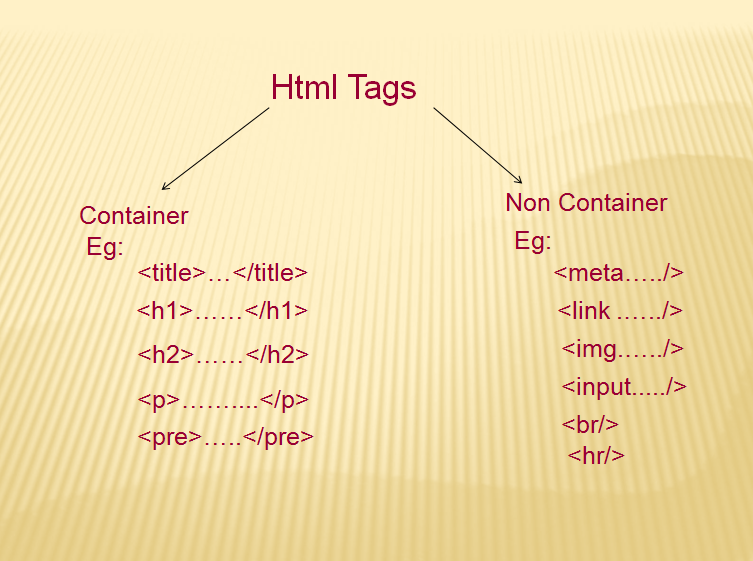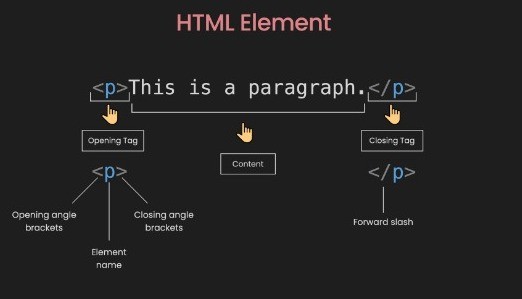HTML 50+ Elements – Learn All Tags from Basic to Advanced
HTML (HyperText Markup Language) is the standard language used to create webpages. Whether you’re a beginner or brushing up your knowledge, understanding HTML elements is essential to structure your content correctly.
In this post, we’ll cover 50+ HTML elements from basic to advanced with short descriptions and examples. Let’s get started
If you’re learning web development, understanding HTML 50+ Elements is essential. These elements form the structure of every webpage.
Type of HTML Elements
there are two type of html elements

There are two type of container html elements
Block-level Elements
A block-level element always starts on a new line, and the browsers automatically add some space (a margin) before and after the element.
A block-level element always takes up the full width available
Two commonly used block elements are: <p> and <div>.
The <p> element defines a paragraph in an HTML document.it is very important element in html
The <div> element defines a division or a section in an HTML document. it take full width because it is block element it is also known as div block
Inline Elements
An inline element does not start on a new line. inline element is more useful compare of block
An inline element only takes up as much width as necessary.it is opposite of block
This is a <span> element inside a paragraph.
Below is a categorized list of HTML 50+ Elements with examples and use cases.
Mastering HTML Elements will make your coding more semantic and organized.
Basic HTML Elements
These tags form the skeleton of an HTML document.
| Tag | Description | Example |
|---|---|---|
<!DOCTYPE> |
Defines the document type | <!DOCTYPE html> |
<html> |
Root of an HTML document | <html lang="en"> |
<head> |
Contains metadata | <head> ... </head> |
<title> |
Sets the page title | <title>My Page</title> |
<meta> |
Defines metadata | <meta charset="UTF-8"> |
<body> |
Contains visible content | <body> ... </body> |
Text Formatting Tags
These tags define headings, paragraphs, and inline formatting.
| Tag | Description | Example |
|---|---|---|
<h1> to <h6> |
Headings from large to small | <h1>Main Heading</h1> |
<p> |
Paragraph | <p>This is a paragraph.</p> |
<br> |
Line break | First line<br>Second line |
<hr> |
Horizontal line | <hr> |
<strong> |
Important text (bold) | <strong>Bold</strong> |
<em> |
Emphasized text (italic) | <em>Italic</em> |
<b> |
Bold text (no emphasis) | <b>Bold</b> |
<i> |
Italic text (no emphasis) | <i>Italic</i> |
<u> |
Underlined text | <u>Underline</u> |
<small> |
Smaller text | <small>Small</small> |
<mark> |
Highlighted text | <mark>Important</mark> |
Link & Image Tags
| Tag | Description | Example |
|---|---|---|
<a> |
Hyperlink | <a href="https://example.com">Visit</a> |
<img> |
Embeds an image | <img src="img.jpg" alt="Image"> |
List Tags
| Tag | Description | Example |
|---|---|---|
<ul> |
Unordered list | <ul><li>Item</li></ul> |
<ol> |
Ordered list | <ol><li>Step 1</li></ol> |
<li> |
List item | <li>Item</li> |
<dl> |
Description list | <dl><dt>Term</dt><dd>Definition</dd></dl> |
Table Tags
| Tag | Description | Example |
|---|---|---|
<table> |
Table | <table> ... </table> |
<tr> |
Table row | <tr> ... </tr> |
<td> |
Table data | <td>Cell</td> |
<th> |
Table heading | <th>Heading</th> |
<thead> |
Table header group | <thead> ... </thead> |
<tbody> |
Table body | <tbody> ... </tbody> |
<tfoot> |
Table footer | <tfoot> ... </tfoot> |
Form Tags
| Tag | Description | Example |
|---|---|---|
<form> |
HTML form | <form action="/submit"> ... </form> |
<input> |
Input field | <input type="text"> |
<textarea> |
Multi-line input | <textarea></textarea> |
<button> |
Button | <button>Click Me</button> |
<label> |
Label for input | <label for="name">Name:</label> |
<select> |
Dropdown list | <select><option>One</option></select> |
<option> |
Option in dropdown | <option>One</option> |
<fieldset> |
Groups form fields | <fieldset> ... </fieldset> |
<legend> |
Title for fieldset | <legend>Details</legend> |
Media Tags
| Tag | Description | Example |
|---|---|---|
<audio> |
Embeds audio | <audio src="song.mp3" controls></audio> |
<video> |
Embeds video | <video src="video.mp4" controls></video> |
<source> |
Media source file | <source src="file.mp4"> |
<track> |
Subtitles or captions | <track src="subs.vtt" kind="subtitles"> |
<iframe> |
Inline frame | <iframe src="https://example.com"></iframe> |
<embed> |
Embeds external content | <embed src="file.swf"> |
Semantic HTML5 Tags
| Tag | Description | Example |
|---|---|---|
<header> |
Page or section header | <header> ... </header> |
<nav> |
Navigation links | <nav> ... </nav> |
<main> |
Main content | <main> ... </main> |
<section> |
Section of content | <section> ... </section> |
<article> |
Independent content | <article> ... </article> |
<aside> |
Sidebar content | <aside> ... </aside> |
<footer> |
Footer content | <footer> ... </footer> |
<figure> |
Self-contained content | <figure> ... </figure> |
<figcaption> |
Caption for figure | <figcaption>Caption</figcaption> |
Programmatic Tags
| Tag | Description | Example |
|---|---|---|
<script> |
JavaScript code | <script>console.log('Hi')</script> |
<noscript> |
Alternate content | <noscript>Your browser doesn't support JS</noscript> |
<style> |
Internal CSS | <style>body { color: red; }</style> |
<link> |
External resources | <link rel="stylesheet" href="style.css"> |
Other Useful Tags
| Tag | Description | Example |
|---|---|---|
<div> |
Generic container | <div class="box"> ... </div> |
<span> |
Inline container | <span style="color:red">Text</span> |
<abbr> |
Abbreviation | <abbr title="HyperText Markup Language">HTML</abbr> |
<address> |
Contact information | <address>123 Main St</address> |
<code> |
Inline code | <code>console.log()</code> |
<pre> |
Preformatted text | <pre>Text as-is</pre> |
<blockquote> |
Quotation | <blockquote>Quote</blockquote> |
<q> |
Short inline quote | <q>Quote</q> |
<cite> |
Citation | <cite>Book Title</cite> |
These 50+ HTML elements are essential building blocks of any webpage. By learning these tags, you can build structured, accessible, and SEO-friendly websites.
Practice writing these tags in a code editor like VS Code, and view them in your browser to see how they work.
This guide on HTML 50+ Elements is perfect for beginners and also helpful for advanced learners.
learn for html introduction click here
For more related references click here
